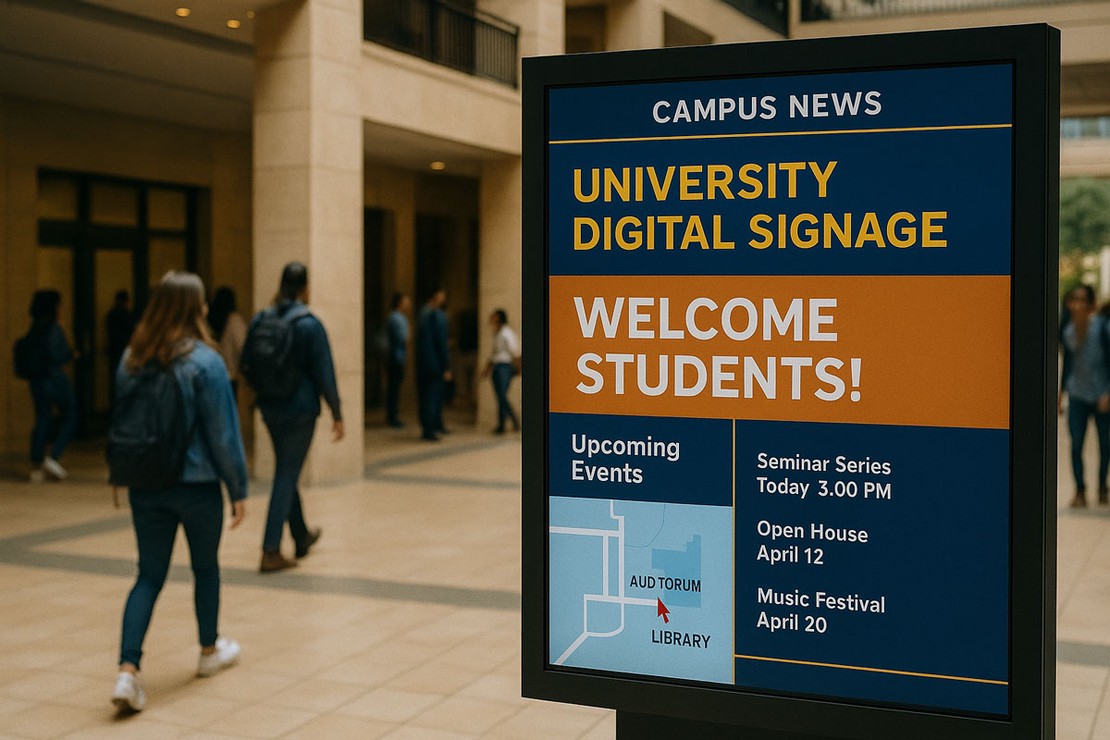10 Best Digital Signage Software Solutions for Businesses in 2025
10 Best Digital Signage Software Solutions for Businesses in 2025 [Expert Guide] What Is Digital Signage Software? Definition and Core Purpose Digital …
Read Article
In today’s hyper-connected world, universities are rapidly embracing digital signage to modernize communication, enhance student engagement, and streamline operations across sprawling campuses. From dynamic digital notice boards to massive outdoor LED screens, digital signage is reshaping how information flows in educational institutions.
Gone are the days when printed posters and bulletin boards were enough to reach students and staff. Universities now require real-time, interactive, and visually engaging communication tools — and digital signage fits that bill perfectly. It’s not just about displaying messages; it’s about creating a smart campus ecosystem that fosters inclusivity, safety, and innovation.
Digital signage refers to electronic display systems (like LCD, LED, or projection screens) used to deliver multimedia content such as announcements, videos, schedules, and alerts. These systems are connected via software or cloud-based platforms, allowing administrators to update content remotely in real-time.
On university campuses, digital signage networks are strategically placed in high-traffic areas — lobbies, libraries, cafeterias, classrooms, and student centers — to ensure maximum visibility and engagement.
Communication in higher education has evolved from printed bulletins to emails, and now to dynamic digital communication. Universities today compete not just on academic quality but also on technological infrastructure. With digital signage, institutions can modernize their image, attract tech-savvy students, and improve the overall campus experience.
Universities are increasingly focusing on smart campus solutions — interconnected systems powered by data and automation. Digital signage fits into this strategy as an efficient, scalable communication platform that can display personalized content, integrate with university databases, and adapt to student needs.
Studies show that visual content captures attention 60,000 times faster than text. By leveraging digital signage, universities can communicate in a way that resonates with modern students — through videos, animations, and social media feeds that keep them informed and involved.
Digital signage enables instant updates about class changes, event reminders, or policy updates. Administrators can push alerts across multiple screens within seconds, ensuring timely communication.
Large campuses can be confusing for new students or visitors. Interactive digital maps and directories make navigation simple, providing directions to buildings, lecture halls, and administrative offices.
In crisis situations — such as weather warnings or security threats — digital signage can instantly broadcast safety alerts, evacuation routes, or shelter information, ensuring swift response and student safety.
From concerts to academic conferences, digital signage keeps everyone informed about upcoming events. It can display live countdowns, promotional videos, or event schedules to boost attendance.
Digital signage is not limited to hallways and lobbies — it’s also transforming classrooms. Professors can use interactive displays for collaborative learning, multimedia lectures, and live data visualization.
In smart classrooms, digital boards can display class materials, video demonstrations, or even live polls. This encourages interactive participation and enhances comprehension.
Group projects and student showcases become more engaging when displayed on large interactive screens. These tools promote teamwork, creativity, and digital literacy — skills essential for the modern workforce.
Administrative staff can use digital signage to share meeting schedules, deadlines, and important notices, reducing the dependence on email chains and printed memos.
Interactive kiosks and displays help visitors explore the campus at their own pace. They can view maps, department details, and upcoming events, creating a more welcoming environment.
Digital signage reinforces a university’s commitment to innovation. Sleek displays and digital storytelling attract prospective students and impress parents during campus visits.
Highlighting achievements on digital screens inspires pride and motivates students. Sharing alumni success stories also enhances the institution’s reputation.
Indoor displays suit hallways, classrooms, and lounges, while outdoor digital signage helps with event promotion, branding, and campus announcements.
Universities use different formats — from large LED video walls to interactive touchscreens — depending on location and purpose.
Cloud-based digital signage offers flexibility, while on-premise systems give universities more control over network management and security.
While initial setup costs can be significant, the long-term return on investment is compelling. Universities save money on printing, improve operational efficiency, and enhance the student experience — benefits that outweigh upfront expenses.
MIT utilizes digital signage to display real-time lab data, event updates, and emergency notifications across its campus.
The University of California integrates interactive screens in student centers, promoting events, dining menus, and sustainability initiatives.
Expect digital signage to evolve through AI-driven personalization, IoT integration, and AR-enhanced experiences. Future campuses will rely on these tools for immersive, data-driven learning environments.
1. What is the main purpose of digital signage in universities?
To improve communication, student engagement, and campus safety through real-time visual displays.
2. How can digital signage enhance student learning?
It supports interactive and multimedia-based learning experiences in classrooms.
3. Is digital signage expensive to maintain?
Modern cloud-based systems are cost-effective and require minimal maintenance.
4. Can digital signage integrate with campus management systems?
Yes, it can integrate with LMS, CRMs, and scheduling tools.
5. Are digital signage systems secure?
Most use encrypted networks and multi-level authentication for protection.
6. What are the key features to look for?
Easy content management, scalability, remote updates, and analytics.
Digital signage for universities is no longer optional — it’s essential. It creates a connected, informed, and interactive campus environment where students thrive, administrators communicate efficiently, and visitors feel welcomed.
By investing in digital signage today, universities prepare for a smarter, more digital future that reflects their innovation and excellence.